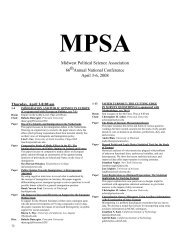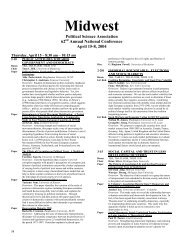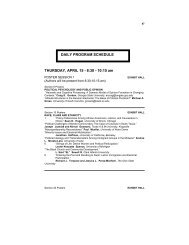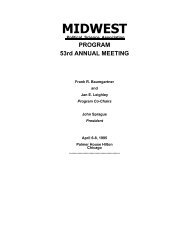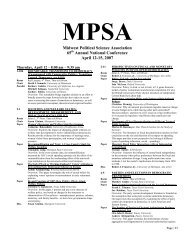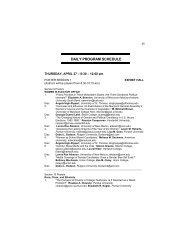PaperDisc.Governmental Structure, Partisanship, and Free Trade inLatin AmericaWilliam D. MacMillan, University of IowaOverview: Research suggests that, in Latin American countries,political variables effectively describe the aggregate volume oftariffs. This work uncovers the conditional nature of partisanand institutional influence in setting the tariff rates.Todd Allee, University of Illinois, Urbana-Champaign13-13 WAR FROM REGIONAL POWERSPERSPECTIVESRoomChairPaperPaperPaperDisc.TBA, Sun 8:30 amAdrian S. Petrescu, University of Texas, BrownsvilleThe India-Pakistan Peace Process: Towards Normalizationof Relations?Arijit Mazumdar, Miami UniversityOverview: The current peace process between India andPakistan represents the most significant opportunity forreconciliation of differences because of the convergence ofinternational and domestic factors that are both crucial andunprecedented.The War on Terror From Regional Powers Perspectives:Indonesia and Saudia ArabiaRibhi I. Salhi, Roosevelt UniversityOverview: Both Saudia Arabia and Indonesia have beenconsidered crucial allies for the war on terror. This paper willexamine the role of the two nations in fighting Alqaeda and itsterror network.It compares the nations' policy in war on terror.Constructing Regional Institutions in Asia: APEC andASEAN+3Yasumasa Komori, University of PittsburghOverview: This paper examines the formation of APEC andASEAN+3 by examining the variation in state preferences overtime and a catalytic role of weaker powers as initiators at thecritical juncture.Adrian S. Petrescu, University of Texas, Brownsville15-11 ECONOMICS AND CONFLICTRoomChairPaperPaperPaperDisc.TBA, Sun 8:30 amMark Crescenzi, University of North CarolinaEconomic Freedom as a Source of International PeaceChristopher G. Ingram, Louisiana State UniversityOverview: While democratic peace may guide the pursuit ofdemocracy to deter international conflict, this paper argues that,for reasons of normative values and economic rationale, policiesthat spread economic freedom could serve equally as a source ofpeace.Bargaining and Economic CoercionValentin L. Krustev, Rice UniversityOverview: Building on the recent informational literature oneconomic sanctions, the paper develops and tests a bargainingmodel of one-sided incomplete information, in which theimposition, escalation, and termination of sanctions aredetermined endogenously.How the Weaker Prevail: An All-Pay Auction Model ofConflict EscalationKeith A. Grant, University of ArizonaOverview: Conflict escalation can be modeled as an All-PayAuction, in which players are required to pay what they bidregardless of who wins the pot. This suggests that disputants'relative power interplays with the salience of the conflict,defining an equilBernadette M. E. Jungblut, University of Central Florida16-7 THEORIZING THE FOREIGN POLICYDECISION MAKING PROCESSRoomChairPaperPaperPaperPaperDisc.TBA, Sun 8:30 amStephen B. Dyson, Wabash CollegeThe Inherent Nuances of American Foreign PolicyConstruction--What an Issue Areas Analysis Can RevealAbout the State-Centrism-Domestic Variables DebateMatthew M. Caverly, University of FloridaOverview: This paper offers an alternative theoreticalconception to analyze American foreign policy by breakingforeign policy down into its component issue areas.Time Horizons, Discounting, and Intertemporal ChoicePhilip A. Streich, Rutgers UniversityJack S. Levy, Rutgers UniversityOverview: Our aim in this paper is to review the literature inbehavioral economics and psychology on discounting andintertemporal choice, and to begin to explore some of theimplications for theories of international conflict.US Foreign Aid and Human RightsWoongjo You, Binghamton University, SUNYOverview: This paper examines the circumstances under whichthe US is more likely to attach the goal of the advancement ofhuman rights practices to foreign aid.Power, Influence, and Bureaucrats: The Role of StatusWithin Foreign Policy FormationEben J. Christensen, University of Wisconsin, MilwaukeeOverview: This paper applies social network analysis andexperimental techniques to examine the influence of status andfeedback within a simulated foreign policy environment.Results indicate such factors alter policy recommendations andinformation selection.R. Michael Smith, Glenville State College18-12 INDIVIDUAL AND CONTEXTUALDETERMINANTS OF POLICYPREFERENCESRoomChairPaperPaperPaperPaperTBA, Sun 8:30 amEvan Parker-Stephen, University of North Carolina, ChapelHillUnderstanding Social Conservatism: Values, Threat, andthe Framing of Issue PreferencesStanley Feldman, Stony Brook UniversityChristopher Weber, Stony Brook UniversityOverview: We examine the personality and situational factorsthat help shape social and moral issue preferences. Resultsindicate that individuals endorsing social conformity, nonegalitarianbeliefs, and who experience a threat to social orderare more likelyLimits of LeadershipRenan Levine, University of TorontoLaura Stephenson, University of Western OntarioOverview: What happens when political and religious leadersconvey conflicting messages? We conducted an experimentwhere we could control the message the respondent received,varying the source (religious or political leader) and the frame.Public Policy Preferences and Perceptions of Inequality andDiscriminationElisabeth R. Gerber, University of Michigan, Ann ArborCharles L. Ballard, Michigan State UniversityJeremy F. Duff, Michigan State UniversityOverview: We analyze the ways in which perceptions ofinequality and discrimination influence preferences on a widevariety of public policy issues. Our data set includes detailedinformation from a survey of over 1000 respondents.The Impact of Economic Inequality on Attitudes of the Richand PoorAlina R. Oxendine, Hamline UniversityOverview: In order to elucidate the relationship betweeneconomic inequality and civic attitudes, this paper uses crosssectionalsurvey data from communities across the US, inconjunction with a quasi-experimental comparison of two ruraltowns.252
PaperDisc.Competing Partisan Frames, Public Opinion and PartyIdentificationMichael W. Wagner, Indiana University, BloomingtonOverview: This paper uses an experimental design (N=133) todemonstrate the conditions under which competitive partisanissue framing can affect public opinion and party identification.Joanne Miller, University of Minnesota19-10 ISSUES AND IDEOLOGY IN VOTE CHOICERoomChairPaperPaperPaperPaperPaperDisc.TBA, Sun 8:30 amSteven E. Galatas, Stephen F. Austin State UniversityIdeology and Evaluation in an Experimental Setting:Proximity vs. DirectionRyan L. Claassen, Kent State UniversityOverview: The debate between which model best describescitizens' political behavior, directional or proximity, remainsunresolved. I report the results of an experiment designed tocontrol many sources of contradictory findings based onobservational studies.Uncovering the Reform Dimension in ContemporaryElectionsDaron R. Shaw, University of Texas, AustinMelvin Hinich, University of Texas, AustinOverview: We argue that a wide range of countries havewitnessed the emergence of a second dimension in recentelections. This dimension is properly understood as pittingcandidates and parties advocating reform versus thoserepresenting established interests.The Cultural Component of Issue Voting: The PartyInterceptSoren R. Thomsen, Aarhus University, DenmarkOverview: The paper presents a comparative study of issuevoting in several democracies trying to understand the meaningof the party intercept in the proximity model as well as in thedirectional model.The Structure, Meaning, and Influence of <strong>Political</strong> IdeologyShawn Treier, University of GeorgiaSunshine Hillygus, Harvard UniversityOverview: Using an item response model (IRT) to estimate ameasure of individual-level ideology, we examine the structureand meaning of ideology and its relationship to partyidentification and the vote.New Evidence on Directional vs. Proximity VotingRobert P. Van Houweling, University of California, BerkeleyMichael R. Tomz, Stanford UniversityPaul M. Sniderman, Stanford UniversityOverview: To advance the debate on directional vs. proximityvoting, we conduct a set of survey experiments (N=2000). Ourmethod allows critical tests that are not possible with standardsurveys.Garrett Glasgow, University of California, Santa BarbaraDean P. Lacy, The Ohio State University21-7 POLITICS OF MAJORITY-MINORITYDISTRICTSRoomChairPaperPaperTBA, Sun 8:30 amGuy-Uriel E. Charles, University of MinnesotaLegislating Without Constraints: The Effect of MinorityDistricting on Legislators' Responsiveness to ConstituencyPreferencesClaudine Gay, Stanford UniversityOverview: Using data on referenda and initiative voting toestimate constituency preferences, I assess the correspondencebetween district opinion and roll call voting for legislators frommajority-minority and majority-white CA Assembly districts.Hurricanes & Rotten BoroughsJohn K. Wildgen, University of New OrleansFritz F. Wagner, University of WashingtonOverview: A Louisiana majority-minority Congressional seatdepended on a dense, homogeneous black populationcompromised by the storm. We examine how contemporaryurban planning theory and redistricting practices might respondto post-Katrina redistricting.PaperDisc.A Unified Theory of Minority-Majority District Effects:Latino LegislatorsEric Gonzalez Juenke, University of Colorado, BoulderRobert R. Preuhs, University of Colorado, BoulderOverview: We combine several important elements of minoritylegislative incorporation into a single theoretical model todemonstrate how institutional arrangements affect the degree towhich racial and ethnic group representatives influence publicpolicy.Guy-Uriel E. Charles, University of MinnesotaDavid L. Leal, University of Texas, Austin22-6 ATTITUDES ABOUT IMMIGRATIONRoomChairPaperPaperPaperPaperDisc.TBA, Sun 8:30 amBrian P. Frederick, Northern Illinois UniversityI Pity the Poor Immigrant…Why Immigrants are moreXenophobic?Daphna Canetti-Nisim, University of HaifaEran Halperin, University of HaifaStevan E. Hobfoll, Kent State UniversityRobert Johnson, University of MiamiOverview: In this study, we examine the differences betweenveteran Israelis versus immigrants from the former SovietUnion (FSU) with regard to the theoretical frameworksexplaining their xenophobic tendencies towards Palestiniancitizens of Israel (PCIs).Skill Mix of Immigrants and Public Attitude TowardImmigration in the U.S.Kyung Joon Han, University of California, Los AngelesOverview: This paper asks how skill mix of immigrants affectspublic attitudes in receiving states toward immigration and findsthat the magnitude of the effect of individual skill level on theattitudes goes along with the fraction of unskilled immigrants.Racializing the Border: How Race, Moral Conservatism,and National Defense Have Shaped Immigration AttitudesBradford Jones, University of ArizonaRegina Branton, Rice UniversityJennifer Byrne, University of ArizonaOverview: This paper examines pre- and post-September 11thattitudes toward immigration. We find that in contrast to thepre-September 11th era, moral conservatism and racialresentment strongly influence attitudes toward immigration.Cross-Generational Attitudes of Latino Groups onImmigrationJason E. Kehrberg, University of KentuckyAdam Butz, University of KentuckyOverview: This study examines the Latino attitudes onimmigration across 3 generations and 5 different Latino groups.Stephen Nuno, University of California, Irvine22-10 VALUES AND CULTURAL ISSUESRoomChairPaperPaperPaperTBA, Sun 8:30 amBeth Miller, Rice UniversityCulture Wars as Identity PoliticsErin C. Cassese, Stony Brook UniversityOverview: In this study, I examine the micro-level dynamicsthought to underlie the culture wars. Using experimental data, Iexplore the effects of social identity and emotional reactions tothreat on social policy attitudes and political tolerance.Ideas About Children and the Red State – Blue State DivideBrian R. Duff, University of New EnglandOverview: The paper examines the effect of the popular ideathat having children is the best way to make life feel meaningfulon people's political attitudes and behaviors.Evolution of the Revolution: Habermas, Foucault, and SexAttitudes 1972-2004Christopher C. Hull, Georgetown UniversityLinnea N. Meyer, Harvard UniversityOverview: Are changes in casual sex imposed by society'spower, or arrived at by collective action? We analyze US trendsin sexual beliefs and behavior using Habermas and Foucault'stheories to test which of the two best explains those changes.253
- Page 1 and 2:
MidwestPolitical Science Associatio
- Page 4 and 5:
9-4 STATE BUILDING AND BUREAUCRATIC
- Page 6 and 7:
14-1 GLOBALIZATION AND SECURITYRoom
- Page 8 and 9:
PaperPaperDisc.The Divide: African
- Page 10 and 11:
29-210 INFORMAL ROUNDTABLE: CULTURE
- Page 12 and 13:
PaperDisc.Defining Federalism: The
- Page 14 and 15:
PaperDisc.estimates connections amo
- Page 16 and 17:
3-26 THE DETERMINANTS OF ECONOMICGR
- Page 18 and 19:
PaperPaperPaperDisc.Bad Civil Socie
- Page 20 and 21:
PaperPaperDisc.Voting Patterns in t
- Page 22 and 23:
PaperDisc.'Going Local': Candidate
- Page 24 and 25:
PaperPaperDisc.90Reflections on Lit
- Page 26 and 27:
Presenter Out of Time: Examining th
- Page 28 and 29:
is: to what extent are intergovernm
- Page 30 and 31:
Presenter Economic Inequality, Its
- Page 32 and 33:
PaperPaperPaperPaperDisc.during the
- Page 34 and 35:
10-3 BACK TO EUROPE? THE EU AND"EUR
- Page 36 and 37:
PaperPaperPaperDisc.Interested Part
- Page 38 and 39:
PaperPaperthatDisc.Don't Know, Don'
- Page 40 and 41:
Disc.Suzanne Soule, Center for Civi
- Page 42 and 43:
epistemology which is attentive to
- Page 44 and 45:
37-3 CONSTITUTIONAL INTERPRETATIONA
- Page 46 and 47:
47-201 INFORMAL ROUNDTABLE: RELIGIO
- Page 48 and 49:
PaperPaperDisc.terms and reciprocal
- Page 50 and 51:
PaperPaperPaperDisc.116Education, E
- Page 52 and 53:
19-202 INFORMAL ROUNDTABLE: YOUNG A
- Page 54 and 55:
26-6 ASIAN AMERICAN POLITICSRoomCha
- Page 56 and 57:
PaperPaperPaperDisc.of how partisan
- Page 58 and 59:
PaperPaperDisc.124An Experimental S
- Page 60 and 61:
PaperPaperDisc.Policy Windows, Atte
- Page 62 and 63:
Friday, April 21 - 8:30 am - 10:15
- Page 64 and 65:
PaperPaperPaperDisc.The Determinant
- Page 66 and 67:
PaperPaperDisc.A Simple Game-Theore
- Page 68 and 69:
PaperDisc.partisans is causing chan
- Page 70 and 71:
28-201 INFORMAL ROUNDTABLE: DEWEY'S
- Page 72 and 73:
35-4 THE EFFECTS OF REDISTRICTING O
- Page 74 and 75:
Presenter Regulation, Enforcement a
- Page 76 and 77:
Friday, April 21 - 10: 30 am - 12:1
- Page 78 and 79:
PaperPaperDisc.144Regional Minority
- Page 80 and 81:
PaperPaperDisc.Administration of Gl
- Page 82 and 83:
PaperPaperPaperDisc.The Paradox Soc
- Page 84 and 85:
Disc.("Policy Mood") since 1972 usi
- Page 86 and 87:
Disc.likelihood of a filibuster is
- Page 88 and 89:
38-301 POSTER SESSION: COMPARATIVEI
- Page 90 and 91:
54-1 SOCIAL ACTIVISM AND CIVICENGAG
- Page 92 and 93:
3-203 INFORMAL ROUNDTABLE: THE LEGA
- Page 94 and 95:
PaperPaperPaperPaperDisc.Toward Res
- Page 96 and 97:
Presenter The Shanghai Cooperation
- Page 98 and 99:
PaperPaperPaperDisc.poised to becom
- Page 100 and 101:
PaperDisc.chapter in Foucault's int
- Page 102 and 103:
PaperDisc.Campaign Ad Images as Sig
- Page 104 and 105:
43-6 INDEPENDENT SCRUTINY OF AGENCI
- Page 106 and 107:
Friday, April 21 - 3:45 pm - 5:30 p
- Page 108 and 109:
6-2 PARTIES AND PARTY DISCIPLINERoo
- Page 110 and 111:
PaperDisc.assesses the impact of co
- Page 112 and 113:
19-301 POSTER SESSION: VOTING BEHAV
- Page 114 and 115:
24-9 WHO LEADS: UNTANGLING THERELAT
- Page 116 and 117:
PaperPaperPaperDisc.182Understandin
- Page 118 and 119:
Paper The Rehnquist Court and the N
- Page 120 and 121:
PaperDisc.Revenge of Socialist Supe
- Page 122 and 123:
Saturday, April 22 - 8:30 am - 10:1
- Page 124 and 125:
PaperDisc.South Korean Public Opini
- Page 126 and 127:
PaperDisc.several other variables b
- Page 128 and 129:
22-15 PRESIDENTIAL APPROVAL (Co-spo
- Page 130 and 131:
PaperDisc.never seems to provide us
- Page 132 and 133:
PaperPaperPaperDisc.Polarization an
- Page 134 and 135:
PaperDisc.Networks of Local Governm
- Page 136 and 137: 47-203 INFORMAL ROUNDTABLE: RELIGIO
- Page 138 and 139: PaperPaperPaperPaperDisc.Between De
- Page 140 and 141: 11-9 NEW THEORIES AND THUS NEWDEBAT
- Page 142 and 143: PaperPaperPaperAre Political Market
- Page 144 and 145: 26-9 MINORITY REPRESENTATIONRoomCha
- Page 146 and 147: PaperDisc.Evolving Political Machin
- Page 148 and 149: PaperPaperPaperDisc.economic gains
- Page 150 and 151: PaperPaperPaperDisc.A Social Versus
- Page 152 and 153: Saturday, April 21 - 1:45 pm - 3:30
- Page 154 and 155: PaperPaperDisc.Riptides in Ontario:
- Page 156 and 157: PaperPaperPaperDisc."works," a stat
- Page 158 and 159: PaperPaperPaperPaperDisc.Preference
- Page 160 and 161: PaperPaperPaperDisc.226that encoura
- Page 162 and 163: 32-12 POLITICAL PARTIES IN ELECTION
- Page 164 and 165: PaperPaperDisc.Challenging Others o
- Page 166 and 167: 52-3 SOCIAL POLICIES: CHALLENGES AN
- Page 168 and 169: Saturday, April 22 - 3:45 pm - 5:30
- Page 170 and 171: PaperDisc.It's Not the Economy Stup
- Page 172 and 173: 15-10 DEMOCRACY, EQUALITY, AND PEAC
- Page 174 and 175: Presenter Polarization, Public Opin
- Page 176 and 177: PaperDisc.John S. Mill and Alexis d
- Page 178 and 179: PaperDisc.Lobbying by Transportatio
- Page 180 and 181: 42-202 INFORMAL ROUNDTABLE: DOMESTI
- Page 182 and 183: Presenter Female Athletes Making He
- Page 184 and 185: PaperPaperDisc.Micro-Level Determin
- Page 188 and 189: PaperDisc.Social Class Identity and
- Page 190 and 191: 33-9 PRESIDENTIAL-CONGRESSIONALRELA
- Page 192 and 193: PaperPaperDisc.Equal Employment Opp
- Page 194 and 195: Sunday, April 23 - 10:30 am - 12:15
- Page 196 and 197: PaperPaperPaperDisc.State Legitimac
- Page 198 and 199: 18-14 THE STUDY AND MEASUREMENT OFR
- Page 200 and 201: 28-14 ROUSSEAU RECONSIDEREDRoomChai
- Page 202 and 203: PaperDisc.The Judicial Treatment of




